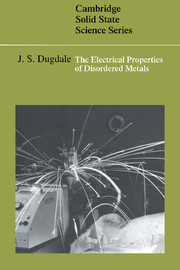Book contents
- Frontmatter
- Contents
- Preface
- 1 Context and content
- 2 Production and structure of metallic glasses
- 3 Electron transport in metals: introduction to conventional theory
- 4 Scattering
- 5 Simple liquid metals: Ziman theory
- 6 Phonons in disordered systems
- 7 Interactions and quasi-particles
- 8 Transition metals and alloys
- 9 The Hall coefficient of metallic glasses
- 10 Magnetoresistance
- 11 Electrical conductivity of metallic glasses: weak localisation
- 12 The interaction effect or Coulomb anomaly
- 13 The effect of the Coulomb interaction on conductivity
- 14 Influence of a magnetic field on the enhanced interaction effect
- 15 The thermopower of metals and alloys
- 16 Comparison with experiment
- Appendices
- Notes
- References
- Index
10 - Magnetoresistance
Published online by Cambridge University Press: 21 January 2010
- Frontmatter
- Contents
- Preface
- 1 Context and content
- 2 Production and structure of metallic glasses
- 3 Electron transport in metals: introduction to conventional theory
- 4 Scattering
- 5 Simple liquid metals: Ziman theory
- 6 Phonons in disordered systems
- 7 Interactions and quasi-particles
- 8 Transition metals and alloys
- 9 The Hall coefficient of metallic glasses
- 10 Magnetoresistance
- 11 Electrical conductivity of metallic glasses: weak localisation
- 12 The interaction effect or Coulomb anomaly
- 13 The effect of the Coulomb interaction on conductivity
- 14 Influence of a magnetic field on the enhanced interaction effect
- 15 The thermopower of metals and alloys
- 16 Comparison with experiment
- Appendices
- Notes
- References
- Index
Summary
Qualitative picture
First of all we concentrate on the transverse magnetoresistance in which the magnetic field is applied normal to the current direction. The calculation of the magnetoresistance of a crystalline material is very difficult unless there are simplifying features. In the metallic glasses fortunately there are indeed such features. If we make the same assumptions as in our first derivation of the Hall coefficient we find zero magnetoresistance. The effect of the magnetic field is so perfectly compensated by the transverse electric field (the Hall field) that the resultant current is completely unperturbed and so there is no change in resistance i.e. no magnetoresistance.
In the alloys of non-transition metals there is only one type of charge carrier and no obvious source of anisotropy so the magnetoresistance due to conventional mechanisms must be vanishingly small.
If there is to be a non-zero magnetoresistance some additional feature has to come into the story. One example of such a feature is the presence of the two different types of charge carrier that we postulated for transition metal alloys.
Two-band model
If we assume that there are two kinds of carrier, we can perhaps understand the physics of this type of magnetoresistance in macroscopic terms as we did for the Hall effect.
- Type
- Chapter
- Information
- The Electrical Properties of Disordered Metals , pp. 100 - 104Publisher: Cambridge University PressPrint publication year: 1995



